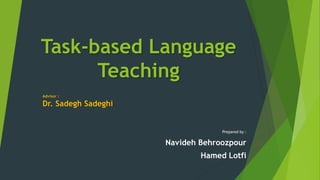
Task-based Language Teaching TBLT
- 1. Task-based Language Teaching Prepared by : Navideh Behroozpour Hamed Lotfi Advisor : Dr. Sadegh Sadeghi
- 3. Versions of Communicative Approach • Weak Version: It gives learners opportunities to practice LANGUAGE for communication. “Learning to use a language” •Strong Version: It asserts that LANGUAGE is acquired through communication. “Using language to learn it” Howatt (1984)
- 4. Although these methods are different but what these have in common is:
- 5. Types of Syllabi Wilkins (1976) Synthetic syllabi: Comprise linguistic units: grammar, structures, vocabulary, functions, etc. Units are ordered in a sequence from Linguistic Simplicity to Linguistic Complexity. Analytic syllabi: Learners work on relevant content text and the form of language according to their purposes. SLA supports analytic because : Shows that learners do not learn linguistic items one at a time, They induce linguistic information from the language samples they work on, and they acquire language items only when they are ready to do so. Both CBI and TBLT falls into the category of an analytic syllabus.
- 6. Task Tasks are Meaningful, and in doing them, students need to communicate. Tasks have a clear Outcome so that the teacher and students know whether or not the communication has been successful.
- 7. Task The central purpose we are concerned with is language learning, and tasks present this in the form of a problem-solving Negotiation between knowledge that the learner holds and new knowledge. Candlin and Murphy (1987) “ ”
- 9. TBLT is another example of the Strong Version of the communicative approach, which means language is acquired through use. (It means that, students learn language when they need it to accomplish the task.)
- 10. Before starting the discussion on the Task-based Language Teaching, to understand what would have been done in real class activity, we have prepared a video of Task-based Language Teaching. Video
- 11. USA, International immigrant language learners’ class, 7min.
- 12. Task based learning is a different way to teach languages. It offers to the students an opportunity to use the target language as they would do in everyday life using their own one. The task is an activity in which students use the language to achieve a specific outcome.
- 13. To plan a TBLT lesson we should follow these stages. Pre-task: The teacher introduces the topic and gives clear instructions for the task Task: Students complete a task in pairs or groups using the language resources that they have. Planning: Students prepare a short report to tell the class what happened during their task. Report: Students then report back to the class orally or read the written report. Analysis: The teacher then highlights relevant parts from the text of the recording for the students to analyze. Practice: Finally, the teacher selects language areas to practice based upon the needs of the students and what emerged from the task and report phases.
- 15. TBLT has some clear advantages: The students are free of language control; they must use all their language resources. A natural context is developed from the students' experiences with the language that is personalized and relevant to them. The language explored arises from the students' needs. It is a strong communicative approach where students spend a lot of time communicating. It is enjoyable and motivating.
- 16. The activity reflects real life and learners focus on meaning; they are free to use any language they want. Playing a game, solving a problem or sharing information or experiences.
- 17. Methodology The teacher will give the topic that is going to be treated. He/she will offer some ideas on how to do things. He/she can show a model to make their ideas clearer. Children will collect information and materials. They will work in groups in class, with the guidance of the teacher. Finally, they will show their projects to the rest of the class.
- 19. End Thank You So Much
